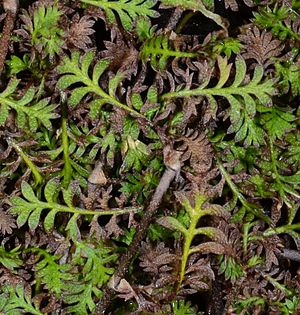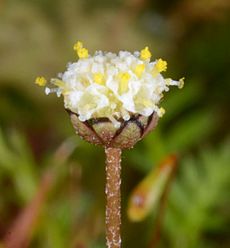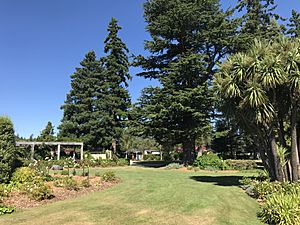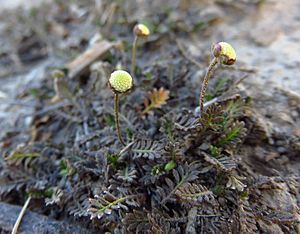Slender button daisy facts for kids
Quick facts for kids Slender button daisy |
|
|---|---|
 |
|
| Conservation status | |
 Nationally Critical (NZ TCS) |
|
| Scientific classification | |
| Genus: |
Leptinella
|
| Species: |
filiformis
|
| Synonyms | |
|
Cotula filiformis Hook.f. |
|
Leptinella filiformis, also known as the slender button daisy, is a type of flowering plant in the daisy family. This special plant is found only in the north-eastern part of the South Island of New Zealand. People thought it had completely disappeared by the 1980s. But then, it was found again growing on a hotel lawn in 1998! Later, in 2015, it was even found growing in the wild.
Contents
What Does the Slender Button Daisy Look Like?
The slender button daisy is a plant that spreads along the ground. It forms a low, flat mat. It grows using thin underground stems called rhizomes that spread out on the soil.
This plant has small, feathery leaves that can be green or brown. They grow up to 2 centimeters (about 0.8 inches) long. Its flowers are tiny, only 2 to 3 millimeters (about 0.1 inches) wide. They look like small white buttons and grow on thin stalks.
How Did It Get Its Name?
The slender button daisy was first collected in 1862 by a person named Julius von Haast. He found it on the Canterbury Plains in New Zealand. He sent it to Joseph Dalton Hooker, a famous botanist. In 1864, Hooker named it Cotula filiformis.
Later, another botanist, David Lloyd, moved this plant to a new group called Leptinella. The name Leptinella comes from a Greek word meaning "thin." This refers to the plant's slender ovary (part of the flower). The second part of its name, filiformis, comes from a Latin word meaning "thread." This describes its thread-shaped look.
Where Does the Slender Button Daisy Live?
This plant is only found in the Marlborough and Canterbury areas of New Zealand's northeast South Island. Even though it was first found on the Canterbury Plains, no more plants were seen there for a long time.
In 1919, a botanist named Leonard Cockayne wrote that the plant had not been seen by anyone in New Zealand for many years. However, it was found again in 1912 by Mr. C.E. Christensen. After that, it was found to be quite common on the Hanmer Plain. Cockayne also found it in the Awatere Valley in Marlborough.
The slender button daisy likes open, bare ground where not many other plants are growing. It grows in grasslands and open shrub areas. You can find it on plains and dry river terraces up to 600 meters (about 2,000 feet) above sea level. Scientists noticed it grew best where rabbits had eaten other plants, leaving bare patches. When the rabbits were gone, other plants grew back and covered the daisy.
Protecting the Slender Button Daisy
The biggest dangers to this plant are when its open habitats are turned into farms or tree plantations. It cannot compete well with common pasture grasses or weeds like hawkweed. In the 1800s, the slender button daisy was common in some areas. But by the 1970s, it was rare. By the 1980s, people thought it was completely gone from the wild.
Rediscovery of the Slender Button Daisy
In November 1998, a botanist named Brian Molloy made an exciting discovery. He found the slender button daisy growing on the grounds of the Hanmer Lodge hotel in Hanmer Springs. There were large patches of the plant on the lawn, mixed with other grasses and weeds. This was the only place it had been seen in recent times. The last known plants from that area were collected in 1975.
In February 1999, Molloy and staff from the Department of Conservation (DOC) collected live plants from the hotel. They wanted to grow more of them. This was a good idea because later in 1999, the hotel grounds were redeveloped. This destroyed all the slender button daisies growing there. The plants they saved were used to grow many more. These new plants were then used for planting in gardens and for putting back into protected wild areas.
In January 2015, a wild group of slender button daisies was found! DOC ranger Jan Clayton-Green found them in the Clarence River Valley on Molesworth Station. She had seen the plant there in 2011 but didn't know what it was. Later, plants she collected grew flowers, and then their identity as Leptinella filiformis was confirmed.




